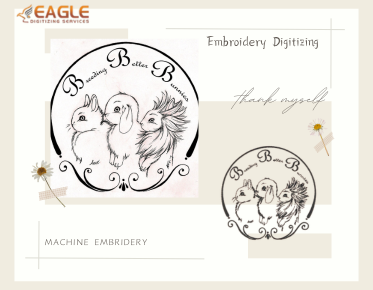How to Trace Embroidery Patterns on Dark Fabric: Expert Tips
Embroidery on dark fabrics presents a
unique set of challenges, but with the right techniques, it can yield stunning
results. Tracing patterns accurately is a crucial step in ensuring that your
embroidery reflects your vision. This guide is tailored to help you navigate
the intricacies of transferring designs onto dark materials, making your
creative process smoother and more enjoyable.
Why Tracing is Essential for
Dark Fabrics
Dark fabrics can obscure the details of
your embroidery patterns, making them difficult to see during the stitching
process. This lack of visibility can lead to mistakes, uneven stitches, and,
ultimately, a project that doesn't meet your expectations. Tracing ensures that
your design is clearly defined and accurately transferred, serving as a reliable
guide as you work. Furthermore, the contrasting colors of the thread against
dark backgrounds can create breathtaking visuals when done correctly,
highlighting your skills and creativity.
Choosing the Right Materials
Best Fabrics for
Tracing Embroidery Patterns
When selecting fabrics for embroidery,
consider those that provide a good balance between structure and flexibility.
Cotton blends, canvas, and lightweight denim are excellent choices, as they
hold patterns well and allow for smooth stitching. Additionally, these fabrics
are less likely to distort when marked, making them ideal candidates for
intricate designs.
Must-Have Tools:
Markers, Light Boxes, and More
Equipping yourself with the right tools
is essential for successful tracing. Fabric markers in contrasting colors are
vital; opt for those that are washable or fade with time to avoid permanent
marks. A light box can significantly enhance precision by illuminating your
pattern, making it easier to trace onto the fabric. Other helpful tools include
tailor’s chalk, which can be easily brushed off, and a good pair of scissors
for trimming excess fabric as needed.
Selecting the Right
Stabilizer for Dark Fabrics
Choosing an appropriate stabilizer is
crucial for maintaining the integrity of your design on dark fabrics. Look for
medium to heavy-weight stabilizers that provide the necessary support without
adding bulk. Tear-away stabilizers are popular as they can be easily removed
after stitching, while cut-away stabilizers provide additional durability for
high-stress areas.
Preparing Your Workspace
Creating an Ideal
Setup for Tracing
A well-organized workspace can make a
world of difference in your embroidery process. Set up a large, flat surface
that is free from clutter, allowing you ample room to work comfortably. Ensure
that your fabric and pattern are easily accessible, and keep your tools within
reach.
Importance of Good
Lighting
Good lighting cannot be overstated; it is
the linchpin of precision in tracing. Position your workspace near a natural
light source, or invest in bright LED lamps that mimic daylight. This will help
illuminate the fabric, making it easier to see both the pattern and any
markings you make.
Keeping Your Tools
Organized
An organized workspace enhances your
efficiency and creativity. Use small containers or a caddy to keep markers,
scissors, and other tools neatly arranged. This way, you can easily grab what
you need without interrupting your flow.
Techniques for Tracing
Patterns
Traditional Methods:
Pencils and Pens
Traditional tracing methods using pencils
or pens are still effective, especially for those who prefer a hands-on
approach. Use a fine-tipped fabric pen for clear, precise lines. Remember to
test your pen on a scrap piece of fabric to ensure it does not bleed or smudge.
Using a Light Box
for Precision
Lightboxes are a game-changer for tracing
patterns on dark fabrics. Simply place your fabric over the illuminated
pattern, allowing the light to shine through and guide your hand as you trace.
This method provides an unparalleled level of accuracy, even for intricate
designs.
The Transfer Method:
How to Make It Work
The transfer method involves printing
your design on transfer paper and then applying it to your fabric. This
approach is especially useful for complex patterns that may be challenging to
trace directly. By following the instructions for your specific transfer paper,
you can achieve crisp, clear lines that are easy to follow.
Exploring Transfer
Papers
What is a Transfer Paper?
Transfer paper is a specialized medium
designed to facilitate the transfer of designs onto fabric. It comes in various
types, including heat transfer and inkjet printable options, making it
versatile for different applications.
How to Use Transfer Paper on Dark Fabrics
To use transfer paper effectively on dark
fabrics, first print your design on the paper according to the manufacturer’s
instructions. Position the printed side down onto your fabric, and use an iron
or heat press to transfer the image. Be cautious with temperature settings to
avoid damaging the fabric.
Best Transfer Papers for Dark Materials
When selecting transfer paper for dark
fabrics, opt for high-quality, opaque options that provide good coverage.
Brands like Avery and Neenah offer products specifically designed for dark
materials, ensuring vibrant results.
Utilizing Digital Tools
Tracing with Digital
Patterns: A Modern Approach
Digital tools have revolutionized the way
we approach embroidery. With design software, you can create, modify, and trace
patterns with remarkable precision. This modern approach not only saves time
but also offers endless possibilities for customization.
Recommended Apps for
Embroidery Design
Several apps cater to embroidery
enthusiasts, allowing you to create and trace patterns seamlessly. Look for
user-friendly options like SewArt or Embrilliance, which provide various tools
for design manipulation and tracing on your device.
Printing and
Transferring Digital Designs
Once you’ve created your digital design,
you can print it on transfer paper or directly onto fabric. Ensure that your
printer settings are adjusted for fabric printing to achieve the best results.
Carefully follow the instructions for your chosen transfer method to guarantee
success.
Step-by-Step Guide to Tracing
Preparing Your
Pattern for Tracing
Before you begin, ensure your pattern is
clear and devoid of any smudges. If necessary, clean it up digitally or
manually for the best results. Use an appropriate size that suits your fabric
and desired embroidery dimensions.
Positioning Your
Pattern on the Fabric
Align your pattern carefully on the
fabric, considering the orientation and placement. If you’re working on a
garment, ensure that the pattern is centered and straight. Use pins or weights
to hold it in place as you trace.
Securing the Fabric
to Avoid Shifts
To prevent the fabric from shifting
during the tracing process, consider using masking tape or fabric weights. This
will keep everything stable and allow for a smoother tracing experience.
Tips for Accurate Tracing
Maintaining Steady
Hands: Techniques to Steady Your Grip
A steady hand is vital for accurate
tracing. To maintain control, rest your elbow on the table and use your fingers
to guide the marker or pencil. Practice on scrap fabric if necessary to build
confidence.
Avoiding Smudges and
Mistakes
To minimize smudges, work carefully and
avoid placing your hand directly on the traced area. Consider using a sheet of
paper or parchment to shield your work as you proceed.
Testing Your Markers
on Scrap Fabric
Before committing to your final fabric,
test your markers on a scrap piece of the same material. This ensures that the
ink behaves as expected and helps you avoid unpleasant surprises later.
Finalizing the Design
Reviewing Your
Traced Pattern for Accuracy
After tracing, take a moment to review
your design for accuracy. Check for any misalignments or errors that may
require correction. It's much easier to fix issues now than after you’ve begun
stitching.
Making Adjustments
Before You Start Stitching
If you notice areas that need adjustment,
don’t hesitate to make changes. This could involve altering lines, adding
details, or even erasing and retracing parts of the design.
Caring for Dark Fabrics
Pre-Washing and
Preparing Dark Fabrics
Pre-washing your dark fabrics is
essential for removing any chemicals or residues. This process can help prevent
shrinkage and color bleeding during the embroidery process. Wash with a mild
detergent, and allow to air dry.
Understanding Colorfastness
in Embroidery
Colorfastness refers to the ability of a
fabric to retain its color despite washing or exposure to light. Choose
high-quality threads that are colorfast to ensure your finished piece retains
its vibrancy over time.
Troubleshooting Common Issues
Dealing with Faded
Lines and Marks
If your traced lines fade during the
stitching process, consider using fabric chalk or a water-soluble marker that
is designed for temporary use. These options will provide clear guidance while
being easy to remove after completion.
Fixing Mistakes in
the Tracing Process
Mistakes happen, and it’s important to
address them promptly. If you’ve made a significant error, consider using a
seam ripper or scissors to carefully cut away the mistake, then retrace the
corrected pattern.
Tips for Handling
Difficult Fabrics
Some fabrics, such as velvet or satin,
can be particularly tricky. Consider using a heavier stabilizer and a sharper
needle for these materials to ensure clean stitching and minimize fabric
shifting.
Embroidery Techniques for
Dark Fabric
Choosing the Right
Threads for Dark Fabrics
Selecting threads that contrast well with
dark fabrics is vital for visibility. Bright or metallic threads can add a
stunning visual element, making your design pop against the backdrop.
Recommended Stitches
for Enhanced Visibility
Certain stitches are more effective on
dark fabrics than others. Opt for bold stitches like satin stitch or outline
stitch that create defined edges and enhance the overall visibility of your
design.
Wrapping Up: Bringing Your
Design to Life
Starting Your Embroidery
Journey
Now that you have traced your pattern and
prepared your fabric, it's time to dive into the exciting world of embroidery.
This process allows for creativity and self-expression, making each piece
uniquely yours.
Celebrating Your
Finished Piece
Once your embroidery is complete, take a
moment to celebrate your hard work. Admire the details and craftsmanship that
went into your piece, and consider how it can be showcased or gifted to someone
special.
Sharing Tips and
Tricks with Fellow Crafters
Embroidery is as much about community as it is about individual creativity. Share your insights and techniques with fellow crafters, fostering a sense of camaraderie and learning within your creative circles.
Tracing embroidery patterns on dark fabrics requires careful planning, the right tools, and a dash of creativity. Embrace the challenges, experiment with techniques, and enjoy the journey of bringing your designs to life. Your unique creations have the potential to inspire others, so don’t hesitate to share your experiences and tips along the way. Happy stitching!



